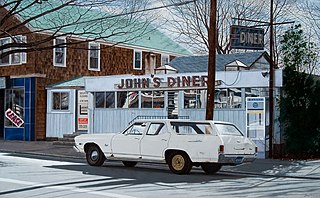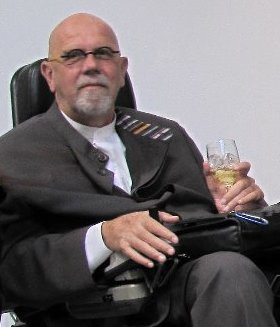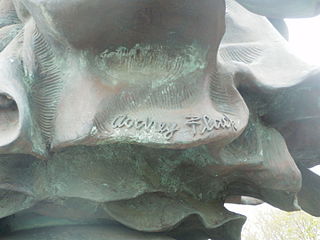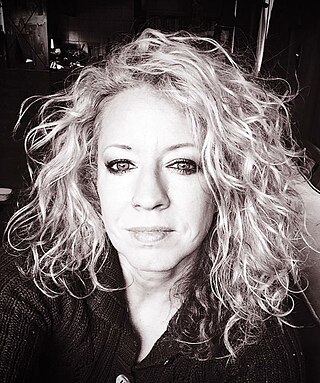Related Research Articles

Photorealism is a genre of art that encompasses painting, drawing and other graphic media, in which an artist studies a photograph and then attempts to reproduce the image as realistically as possible in another medium. Although the term can be used broadly to describe artworks in many different media, it is also used to refer specifically to a group of paintings and painters of the American art movement that began in the late 1960s and early 1970s.

Charles Thomas Close was an American painter, visual artist, and photographer who made massive-scale photorealist and abstract portraits of himself and others. Close also created photo portraits using a very large format camera. He adapted his painting style and working methods in 1988, after being paralyzed by an occlusion of the anterior spinal artery.

Ida Applebroog was an American multi-media artist who was best-known for her paintings and sculptures that explore the themes of gender, sexual identity, violence, and politics. Applebroog was the recipient of multiple honors including the MacArthur Fellowship "Genius Grant", the College Art Association Distinguished Art Award for Lifetime Achievement, and an Honorary Doctorate of Fine Arts from the New School for Social Research/Parsons School of Design. Applebroog lived in New York City and is represented by Hauser & Wirth.

Audrey Flack is an American artist. Her work pioneered the art genre of photorealism and encompasses painting, printmaking, sculpture, and photography.
Denis Peterson is an American hyperrealist painter whose photorealist works have been exhibited at the Brooklyn Museum, Whitney Museum of American Art, Butler Institute of American Art, Tate Modern, Springville Museum of Art, Corcoran MPA, Museum of Modern Art CZ and Max Hutchinson Gallery in New York.

Hyperrealism is a genre of painting and sculpture resembling a high-resolution photograph. Hyperrealism is considered an advancement of photorealism by the methods used to create the resulting paintings or sculptures. The term is primarily applied to an independent art movement and art style in the United States and Europe that has developed since the early 1970s. Carole Feuerman is the forerunner in the hyperrealism movement along with Duane Hanson and John De Andrea.
Thomas Leo Blackwell was an American hyperrealist of the original first generation of Photorealists, represented by Louis K. Meisel Gallery. Blackwell is one of the Photorealists most associated with the style. He produced a significant body of work based on the motorcycle, as well as other vehicles including airplanes. In the 1980s, he also began to produce a body of work focused on storefront windows, replete with reflections and mannequins. By 2012, Blackwell had produced 153 Photorealist works.
Idelle Lois Weber was an American artist most closely aligned with the Pop art and Photorealist movements.

Robert Neffson is an American painter known for his photorealistic street scenes of various cities around the world, museum interiors and for early still lifes and figure paintings.

The Parrish Art Museum is an art museum designed by Herzog & de Meuron Architects and located in Water Mill, New York, whereto it moved in 2012 from Southampton Village. The museum focuses extensively on work by artists from the artist colony of the South Shore and North Shore.

Gus Heinze is an American photorealist painter.
John C. Kacere was an American painter. Originally an abstract expressionist, Kacere adopted a photorealist style in 1963. Nearly all of his photorealist paintings depict the midsection of the female body. He is considered one of the original photorealists, although he rejected the term.
David Pagel is an American art critic, educator, curator, dioramatist and bike enthusiast.

Donald Lipski is an American sculptor best known for his installation work and large-scale public works.
Louis K. Meisel is an American author, art dealer and proponent of the photorealist art movement, having coined the term in 1969. He is also the owner of one of the earliest art galleries in SoHo at 141 Prince Street. In addition to Photorealism, Meisel is responsible for the resurgence of interest in the sub-set of American illustration identified as "Pin-up", and is the largest collector of original art of both genres. Louis and Susan Meisel own the largest collections of Photorealism and pin-up art in the world.
Roberto Bernardi is a photorealist painter who explores the beauty of everyday life though the reflections and transparencies in his still life paintings, using as his main subject plates and glasses, kitchens appliances, dishwashers, fridges and more recently lollypops and candies.

Yigal Ozeri is an Israeli artist based in New York City. He is known for large-scale cinematic portraits of young women in landscapes. As one of the leading Photorealism painters, his large-scale oil paintings tend to capture ethereal scenes of women in nature. His son is Adam Ozeri, a professional soccer player.

Cheryl Kelley is an American painter known for her photorealism, especially her paintings of classic and muscle cars. Her work has been featured on the cover of Harper's Magazine and can be seen at the Scott Richards Contemporary Art gallery in San Francisco, California, the Bernarducci·Meisel Gallery in New York City, New York, and the Seven Bridges Foundation in Greenwich, Connecticut. In 2009 and 2011 she was a finalist for the Hunting Art Prize, and in 2012 she received a Pollock-Krasner Foundation grant. The art collectors' resource Artsy considers her one of ten "Masters of Photorealism".

Maurizio Pellegrin is an Italian and American visual artist. He works with installations, photography and video. He is married and has two sons.

Rodney Carswell is an American abstract artist. He first gained recognition for human-scaled, geometric paintings that feature exposed, projected support structures, creating interplay between sculptural presence and richly painted pictorial surfaces. His recent paintings eschew the superstructures and evoke a greater sense of immediacy, playfulness, and narrative. Critics often describe Carswell's work as uncanny, elusive or quirky, for its tendency to negotiate "in-between" spaces and embrace contradictions such as order and instability, intention and accident, or back and front. Employing irregularly shaped canvasses, thick supports, and openings or holes that reveal the stretcher construction and walls behind them, works like 3 (1994) often occupy a place between painting and sculpture. In a similar way, Carswell uses the modernist languages of Minimalism, Suprematism and Constructivism, yet eludes those categories with postmodern allusions to architecture, the body and spiritual iconography, and with his process-oriented, "hand-made" surfaces. In his essay for Carswell's mid-career retrospective at Chicago's Renaissance Society, Los Angeles Times critic David Pagel suggested that his understated paintings worked their way into one's consciousness in a "supple, somewhat unsettling manner" that achieves a subtle, but lingering shift in perception.
References
- 1 2 3 4 27East, At Home With Terrie Sultan, Aimee Fitzpatrick Martin (13 July 2008)
- ↑ amazon.com Author Page, Terrie Sultan. Accessed 19 August 2015
- ↑ New York Times architecture critic Nicolai Ouroussoff on Herzog & de Meuron's design for the New Parrish Art Museum
- ↑ New York Times's Carol Vogel on the groundbreaking ceremony of the New Parrish Art Museum